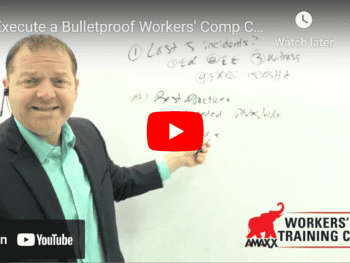
It All Starts with Workplace Safety
Best claim practices start with preventing the injury from occurring. Members of the claim management team work with their insureds to assist in helping them build a better program and enhance what is being done right. Most of these steps are cost-effective and easy to implement.
- Provide all workplaces with a sample first-aid kit. This will assist employers in understanding what should be in a kit. Provide instruction on where to place it and why it is crucial to keep it stocked.
- Provide insureds with best practices on workplace safety. This should include information on who to communicate the information with employees and how often it should be shared.
- Ensure that workplace safety has buy-in from upper management. Demonstrate how it can improve workplace safety when the workforce sees a commitment to safety and empower the workforce to speak up when they have a suggestion.
It is impossible to eliminate injuries from the workplace. However, it is of utmost importance that the safety message is promoted effectively.
Promote Best Practices in Injury Response
Work injuries happen. How an employer responds can set the course of the claim. Workers’ compensation costs can be reduced through immediate response and timely incident reporting.
- Provide employers with the ability to report a work injury promptly. This should include multiple platforms for filing an injury report. This can include telephone and web/app-based reporting platforms.
- Provide training and resources regarding effective first-aid. All employees must have a basic understanding of appropriate and effective first aid. This should also include training to summon emergency medical services for severe injuries.
- Offer telephonic nurse triage services. This tool can enhance the response to a work injury and assist supervisors and managers in making decisions. It can also direct medical care for employees with non-life threatening injuries.
Now is the time to assist insureds in having a more effective post-injury response. This also assists in reporting a work injury and collecting all information promptly.
Focus on Return to Work
A work injury is a significant life event for anyone. Even if the injury is admitted and workers’ compensation benefits are being paid, there is a disruption in the employee’s financial status. Now is the time for all interested stakeholders to make a return to work a part of their post-injury response.
- Encourage insureds to designate a “Return to Work Coordinator.” This person should be able to effectuate change within an organization and make a change. This person should also have access to all interested stakeholders within an organization.
- Encourage the employer representatives or Coordinator to have consistent contact with the employee. This can include a visit to the employee’s home. Not only does this allow for a better evaluation of the injury, but it can also demonstrate compassion and empathy.
- Encourage insureds to think outside the box when returning to work. Creative options can include taking advance of the Ticket to Work program run through the Social Security Administration and “work on loan” options.
Countless studies have demonstrated that the people who return to work on time receive less medical care. This translates into program savings. Now is the time to consider or enhance return to work efforts.
Emphasize Compassion and Empathy
All injured employees (regardless of credibility) deserve to be treated with respect and dignity. Avoid approaching the injured employee with skepticism. Send the employee a “get better soon” card and make efforts to explain the process and what to expect.
Conclusions
The school will soon be back in session. Now is the time to consider your “claims curriculum” and be ready to implement it. Simple steps such as emphasizing workplace safety and having an effective injury response can drive claims toward resolution. Other matters to consider should include focusing on returning to work and training, all with respect and dignity. Considering these items can improve the claim process and reduce program costs.
 Author Michael Stack, CEO Amaxx LLC. He is an expert in workers’ compensation cost containment systems and helps employers reduce their workers’ comp costs by 20% to 50%. He works as a consultant to large and mid-market clients, is a co-author of Your Ultimate Guide To Mastering Workers Comp Costs, a comprehensive step-by-step manual of cost containment strategies based on hands-on field experience, and is the founder & lead trainer of Amaxx Workers’ Comp Training Center, which offers the Certified Master of Workers’ Compensation national designation.
Author Michael Stack, CEO Amaxx LLC. He is an expert in workers’ compensation cost containment systems and helps employers reduce their workers’ comp costs by 20% to 50%. He works as a consultant to large and mid-market clients, is a co-author of Your Ultimate Guide To Mastering Workers Comp Costs, a comprehensive step-by-step manual of cost containment strategies based on hands-on field experience, and is the founder & lead trainer of Amaxx Workers’ Comp Training Center, which offers the Certified Master of Workers’ Compensation national designation.
Contact: mstack@reduceyourworkerscomp.com.
Workers’ Comp Roundup Blog: http://blog.reduceyourworkerscomp.com/
©2022 Amaxx LLC. All rights reserved under International Copyright Law.
Do not use this information without independent verification. All state laws vary. You should consult with your insurance broker, attorney, or qualified professional.















